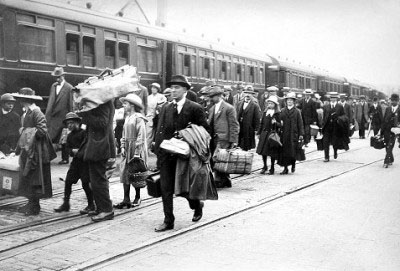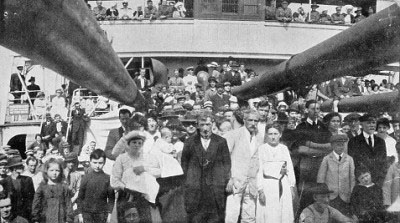During research for ‘An Industrial Invasion’, I came across the story of about 6000 Australian civilian men who volunteered to go and work in British factories during WWI an effort Winston Churchill called ‘An Industrial Invasion’, a phrase I used as the title of the book on that subject.
Embedded in that saga is a tale that begins in Britain, in Plymouth, and ends in Australia, in Melbourne: the ‘Bahia Castillo’ Royal Commission in October 1919.
As WWI settled into stalemate on the Western Front, Britain struggled to supply replacement troops and also manufacture munitions. As more men were conscripted, less were left to build and man the factories. Women were employed in munitions factories, but there remained a shortfall that threatened victory.
In 1915, the British Vickers organisation began recruiting Australian tradesmen through their Victorian representative, William Adams Ltd. Almost 1000 men signed up before the Australian Government established its own scheme and recruited over 5000 more. These two efforts, plus ex-AIF men who joined in Britain, put about 6500 men into British industry. About 2200 were labourers, The scheme – the Munition Worker tradesmen and War Worker navvies, as they were called – was a huge success. Some went for the beer; others to rejoin their British families; others to escape humdrum lives; but the majority – at least 90 percent – were invaluable and greatly missed when they left.
And they did have to leave at war’s end, it was in their contracts. Many British-born men had dependents in Britain, often wives and children, and were reluctant to leave them behind again; and many others had married while there and now also had wives and children they mostly didn’t want to leave. Some had tangled love lives. To encourage departure, the British Government offered to pay the dependent’s fares to Australia on specially equipped ‘family ships’ carrying doctors and nurses, and with facilities for children.
One such was the ‘Bahia Castillo’. Of 9959 tons, built for the German Hamburg South American Line in 1913, it had been laid up during the war, then surrendered to the British in 1919. Its configuration for 2000 passengers was upgraded to take only half that many as a ‘family ship’. For this voyage it carried 586 Munition Workers, 342 wives and children, and 21 Army medical personnel. After refuelling and re-fitting in Liverpool, it docked in Plymouth on the 14th of July 1919, still filthy from re-coaling and still short of basic supplies.

The passengers were waiting but immediately after boarding began complaining about sub-standard conditions. Phone call were made and telegrams sent to Australian authorities in Britain. Some matters that could be rectified were; but others were the result of the war and had to be endured. The Australian authorities took their responsibilities seriously, and did their best, but could not satisfy every demand. The crew were unfamiliar with the ship, its engines, its plumbing and its galley equipment. Some passengers wanted to get off; they were told to stay aboard or lose their right to a free passage home. The ship sailed on the 18th of July.
The trip to Cape Town was an unhappy one. Many passengers had unrealistic visions of a pre-war ocean voyage, with sparkling table settings and uniformed stewards satisfying their every whim. But it wasn’t so. There were no table cloths or bread-and-butter plates for the first few days, and the stewards were as sick of the war as was everyone else. The baker struggled with poor yeast and an unfamiliar oven to make bread that didn’t bounce when dropped, and the cooks did their best with potatoes somewhat past their prime. Passengers took such long baths and showers that fresh water supplies had to be rationed, a move that saw stewards threatened with being thrown overboard. War broke out between passengers and crew. Some foods, such as jam, that could have continued in use over many meals, was spoiled with cigarette butts. Toilets were blocked with tealeaves. Taps were left running. Undoubtedly the stewards retaliated within the limits of maritime discipline.
The stop at Cape Town saw a blizzard of complaints telegrammed to Britain and Australia, and a certain amount of binge drinking ashore by both parties. The ship’s South African Agents dismissed most complaints. The ship left to re-coal at Durban on the 19th of August; it left Durban on the 22nd.
At sea on the night of the 23rd, a large, rowdy gathering of passengers calling out threats to captain and crew so alarmed the ship’s and Army officers that the Bahia Castillo returned to Durban. The Army considered disembarking the nurses for their own safety. Finally, a contingent of armed Australian soldiers was taken aboard for the protection of the crew and the more orderly passengers. The troops were greeted with insults as they boarded and had to use force to evict men from the area assigned to them. The men vandalised fittings before leaving.
At least the threats largely stopped on the voyage to Fremantle, but the atmosphere was tense, and not helped when a rough sea caused the blocked sewerage system to regurgitate its contents while in use.

Another blizzard of telegrams followed arrival in Fremantle. The captain had forewarned naval authorities and they offered an official enquiry. The passengers’ committee refused and all the unhappy passengers left the ship and declined to re-embark while the soldiers remained. The Navy declined to remove the soldiers, so the ship sail for Albany, taking all the luggage of the 510 passengers watching from the wharf.
The situation now became political: Labor Party people in Fremantle helped find accommodation, sympathetic articles appeared in the newspapers – it was all the Hughes’ Government’s fault. Luggage was unloaded at Albany and returned to Fremantle; passengers faced a train trip home if they didn’t rejoin soon, and the ship wanted to leave Albany.
Finally, a compromise was reached: Hughes offered a Royal Commission once the ship reached Melbourne; committee leaders would proceed by train; a Government appointee and his wife would travel on the ship to Melbourne to evaluate and observe. The passengers were taken to Albany by train; the ship sailed on the 9th of October.
Hughes wanted this all to go away, quickly. He faced a general election with Labor criticising his handling of the war and didn’t need this distraction.
A Police magistrate chaired the Commission. It met on the 17th of October and several dates in December after interstate witnesses returned to Melbourne. Evidence was, to say the least, colourful. Melbourne newspapers reported in great, sensational detail the stories from both sides of the dispute, far too much to list here. The report was ready on Christmas Eve, but wasn’t public until Parliament sat on the 26th of February.
In the end, the Commissioner’s report favoured the ship. There were problems, undeniably, and exacerbated by the attitudes of the ship’s master and the officer commanding the military detail, but wartime, passenger’s expectations and reactions were too extreme.
Public reaction has not been explored. In the context of the war, however, these men were civilians, whereas the nation was mourning the deaths of almost 60,000 men and the physical or psychological wounding of several hundred thousand. A few hundred disgruntled civilians were beneath consideration.
Contact Tony Griffiths about this article.






